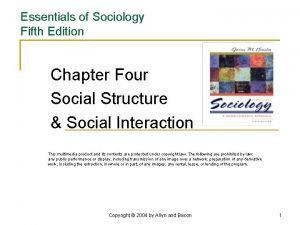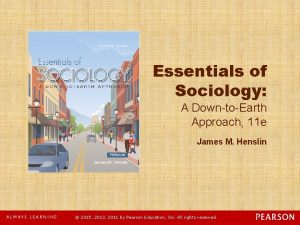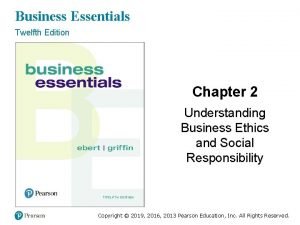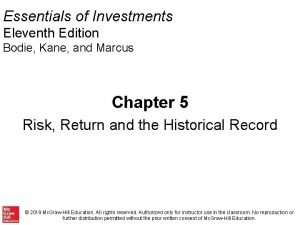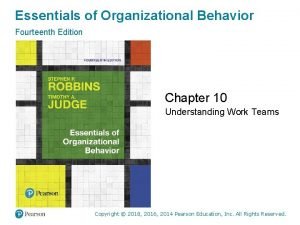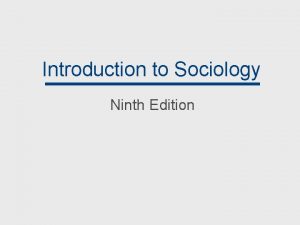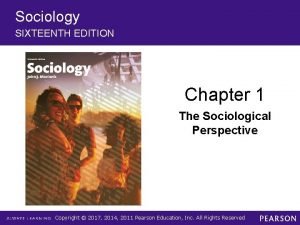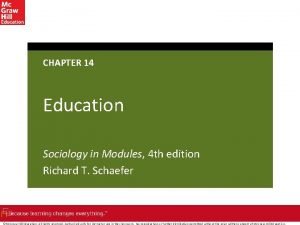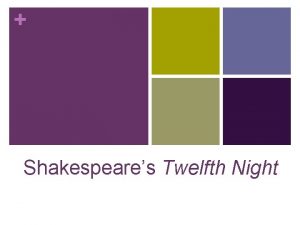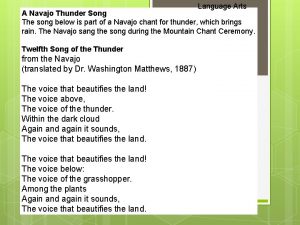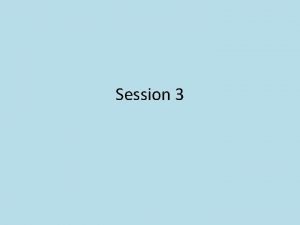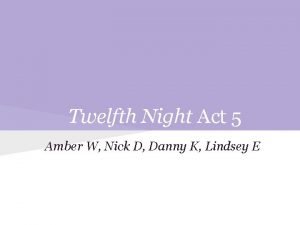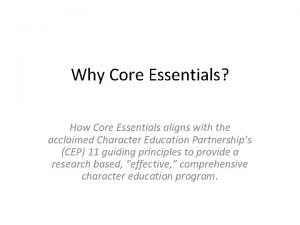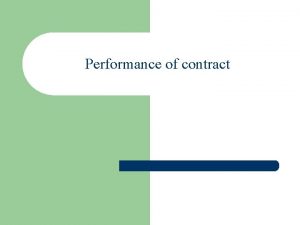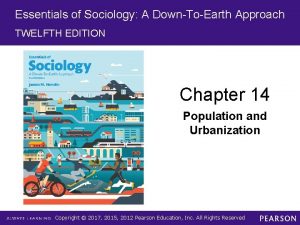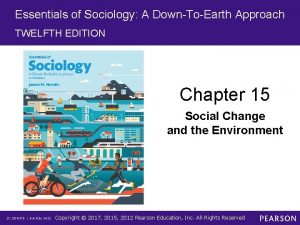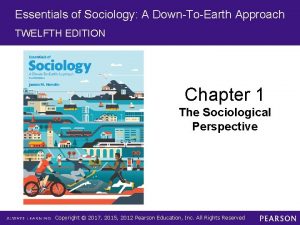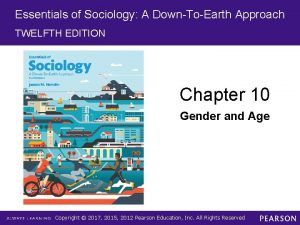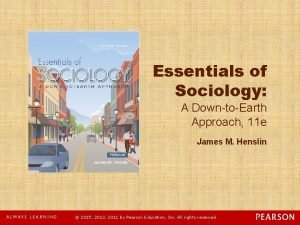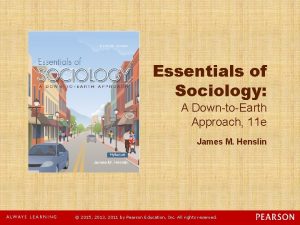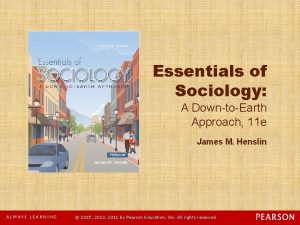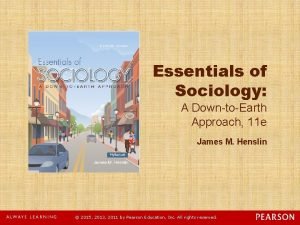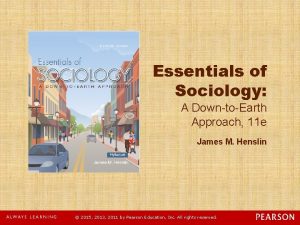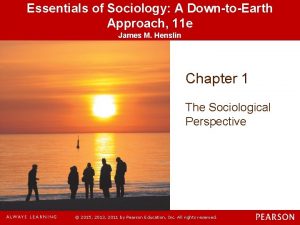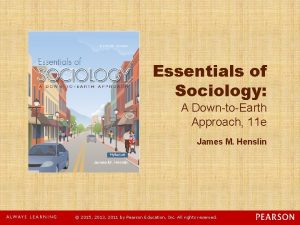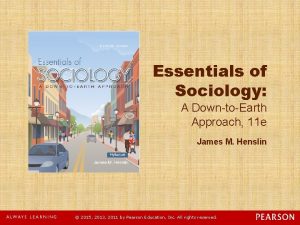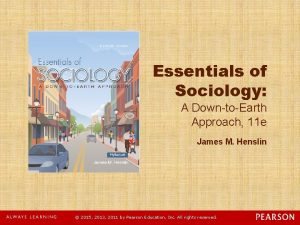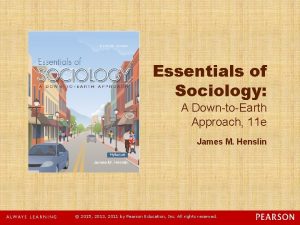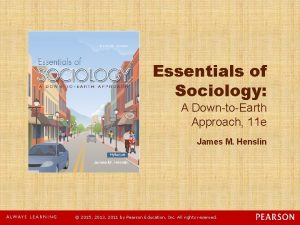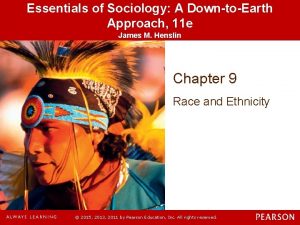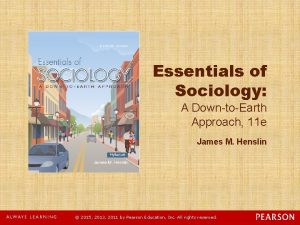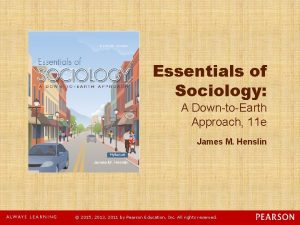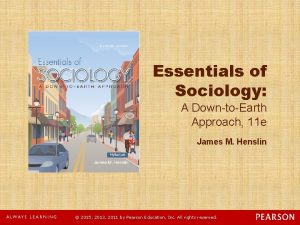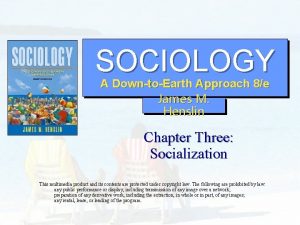Essentials of Sociology A DownToEarth Approach TWELFTH EDITION


























































- Slides: 58

Essentials of Sociology: A Down-To-Earth Approach TWELFTH EDITION Chapter 11 Politics and the Economy Copyright © 2017, 2015, 2012 Pearson Education, Inc. All Rights Reserved

Learning Objectives (1 of 4) 11. 1 Contrast power, authority, and violence; compare traditional, rational- legal, and charismatic authority; explain authority as an ideal type 11. 2 Compare monarchies, democracies, dictatorships, and oligarchies Copyright © 2017, 2015, 2012 Pearson Education, Inc. All Rights Reserved

Learning Objectives (2 of 4) 11. 3 Discuss voting patterns, lobbyists, and PACs 11. 4 Compare the functionalist (pluralist) and conflict (power elite) perspectives on U. S. power 11. 5 Explain why countries go to war and why some groups choose terrorism; discuss targeted killings Copyright © 2017, 2015, 2012 Pearson Education, Inc. All Rights Reserved

Learning Objectives (3 of 4) 11. 6 Summarize the broad historical shifts in economic systems; emphasize inequality 11. 7 Contrast capitalism and socialism: their components, ideologies, criticisms, and convergence Copyright © 2017, 2015, 2012 Pearson Education, Inc. All Rights Reserved

Learning Objectives (4 of 4) 11. 8 Discuss the globalization of capitalism, including its effects on workers, the divisions of wealth, and the global superclass 11. 9 Explain how the globalization of capitalism might be bringing a New World Order Copyright © 2017, 2015, 2012 Pearson Education, Inc. All Rights Reserved

LO 11. 1 Power, Authority, and Violence (1 of 5) • Authority and Legitimate Violence • Traditional Authority • Rational-Legal Authority • Charismatic Authority • Authority as Ideal Type • The Transfer of Authority Copyright © 2017, 2015, 2012 Pearson Education, Inc. All Rights Reserved

LO 11. 1 Power, Authority, and Violence (2 of 5) The ultimate foundation of any political order is violence, no more starkly demonstrated than when a government takes a human life. This iconic photo from the war in Vietnam shows the chief of the national police shooting a suspected Viet Cong officer. Copyright © 2017, 2015, 2012 Pearson Education, Inc. All Rights Reserved

LO 11. 1 Power, Authority, and Violence (3 of 5) For centuries, widows in the Mediterranean countries, such as thise widow in Greece, were expected to dress in black and to mourn for their husbands the rest of their lives. Widows conformed to this expression of lifetime sorrow not because of law, but because of custom. As industrialization erodes traditional authority, fewer widows follow this practice. Copyright © 2017, 2015, 2012 Pearson Education, Inc. All Rights Reserved

LO 11. 1 Power, Authority, and Violence (4 of 5) One of the best examples of charismatic authority is Joan of Arc. In this painting from the early 1900 s, she is shown holding the standard and leading her men. The artist has maintained her femininity by adding a skirt. Copyright © 2017, 2015, 2012 Pearson Education, Inc. All Rights Reserved

LO 11. 1 Power, Authority, and Violence (5 of 5) Charismatic authorities can be of any morality, from the saintly to the most bitterly evil. Like Joan of Arc, Adolf Hitler attracted throngs of people, providing the stuff of dreams and arousing them from disillusionment to hope. This poster from the 1930 s, titled Es Lebe Deutschland (“Long Live Germany”), illustrates the qualities of leadership that Germans of that period saw in Hitler. Copyright © 2017, 2015, 2012 Pearson Education, Inc. All Rights Reserved

LO 11. 2 Types of Government (1 of 3) • Monarchies: The Rise of the State • Democracies: Citizenship as a Revolutionary Idea • Dictatorships and Oligarchies: The Seizure of Power Copyright © 2017, 2015, 2012 Pearson Education, Inc. All Rights Reserved

LO 11. 2 Types of Government (2 of 3) This classic painting, “Siege at Yorktown” by Louis Coulder, depicts George Washington and Jean de Rochambeau giving the final orders for the attack on Yorktown in 1781. This turned out to be the decisive battle of the American Revolution, allowing the fledgling U. S. democracy to proceed. Copyright © 2017, 2015, 2012 Pearson Education, Inc. All Rights Reserved

LO 11. 2 Types of Government (3 of 3) Democracy (or “democratization”) is a global social movement. People all over the world yearn for the freedoms that are taken for granted in the Western democracies. Shown here is a tribal leader voting in the Philipines. Copyright © 2017, 2015, 2012 Pearson Education, Inc. All Rights Reserved

LO 11. 3 The U. S. Political System (1 of 10) • Political Parties and Elections • Contrast with Democratic Systems in Europe • Voting Patterns • Lobbyists and Special-Interest Groups Copyright © 2017, 2015, 2012 Pearson Education, Inc. All Rights Reserved

Figure 11. 1 Which Political Party Dominates? SOURCE: By the author. Based on Book of the States 2014: Table 3. 3. Note: Domination by a political party does not refer to votes for president or Congress. This social map is based on the composition of the states’ upper and lower houses. When different parties dominate a state’s houses, the total number of legislators was used. In Nebraska, where no parties are designated, the percentage vote for president was the determining factor. Copyright © 2017, 2015, 2012 Pearson Education, Inc. All Rights Reserved

LO 11. 3 The U. S. Political System (2 of 10) Although the Democrats and the Republicans represent slightly different slices of the center, those differences arouse extreme emotions, pandered to by both parties. Copyright © 2017, 2015, 2012 Pearson Education, Inc. All Rights Reserved

LO 11. 3 The U. S. Political System (3 of 10) From The Wall Street Journal, permission Cartoon Features Syndicate Copyright © 2017, 2015, 2012 Pearson Education, Inc. All Rights Reserved

LO 11. 3 The U. S. Political System (4 of 10) Table 11. 1 Who Votes for President? 1988 1992 1996 2000 2004 2008 2012 57% 61% 54% 55% 58% 57% 18– 20 33% 39% 31% 28% 41% 35% 21– 24 46% 33% 35% 43% 47% 40% 25– 34 48% 53% 44% 47% 49% 46% 35– 44 61% 64% 55% 57% 55% 53% 45– 64 68% 70% 64% 67% 65% 63% 65 and older 69% 70% 67% 68% 69% 68% 70% Male 56% 60% 53% 56% 54% Female 58% 62% 56% 60% 59% Overall Americans Who Voted Age Sex Copyright © 2017, 2015, 2012 Pearson Education, Inc. All Rights Reserved

LO 11. 3 The U. S. Political System (5 of 10) Table 11. 1 Who Votes for President? 1988 1992 1996 2000 2004 2008 2012 Whites 64% 70% 56% 60% 58% African Americans 55% 59% 51% 54% 56% 61% 62% NA 54% NA 25% 30% 32% 31% 48% 52% 27% 28% 32% Some high school 41% 34% 35% 34% 32% High school graduates 55% 58% 49% 52% 51% 49% Some college 65% 69% 61% 60% 66% 65% 62% College graduates 78% 81% 73% 72% 74% 73% 72% Race–Ethnicity Asian Americans Latinos Education Copyright © 2017, 2015, 2012 Pearson Education, Inc. All Rights Reserved

LO 11. 3 The U. S. Political System (6 of 10) Table 11. 1 Who Votes for President? 1988 1992 1996 2000 2004 2008 2012 Married NA NA 66% 67% 71% 70% 63% Divorced NA NA 50% 53% 58% 59% 56% Employed 58% 64% 55% 56% 60% 59% Unemployed 39% 46% 37% 35% 46% 49% 46% Under $20, 000 NA NA 48% 52% 48% $20, 000 to $30, 000 NA NA 58% 56% $30, 000 to $40, 000 NA NA 62% 58% Marital Status Labor Force Income 1 Copyright © 2017, 2015, 2012 Pearson Education, Inc. All Rights Reserved

LO 11. 3 The U. S. Political System (7 of 10) Table 11. 1 Who Votes for President? 1988 1992 1996 2000 2004 2008 2012 $40, 000 to $50, 000 NA NA 69% 65% 63% $50, 000 to $75, 000 NA NA 72% 71% 68% $75, 000 to $100, 000 NA NA 78% 76% 74% Over $100, 000 NA NA 81% 92% 79% 1 The primary source changed the income categories in 2004, making the data from earlier presidential election years incompatible. SOURCES: By the author. Based on Casper and Bass 1998; Jamieson et al. 2002; Holder 2006; Current Population Survey: Voting and Registration Supplement, 2012; Statistical Abstract of the United States 1991: Table 450; 1997: Table 462; 2014: Table 418. Copyright © 2017, 2015, 2012 Pearson Education, Inc. All Rights Reserved

LO 11. 3 The U. S. Political System (8 of 10) Table 11. 2 How the Two-Party Presidential Vote Is Split 1988 1992 1996 2000 2004 2008 2012 Democrat 50% 61% 65% 56% 53% 57% 55% Republican 50% 39% 35% 44% 47% 43% 44% Democrat 44% 55% 51% 47% 46% 52% 45% Republican 56% 45% 49% 53% 54% 48% 52% Democrat 92% 94% 99% 92% 90% 99% 93% Republican 8% 6% 1% 8% 10% 1% 6% Democrat 41% 53% 54% 46% 42% 44% 39% Republican 59% 47% 46% 54% 58% 56% 59% Women Men African Americans Whites Copyright © 2017, 2015, 2012 Pearson Education, Inc. All Rights Reserved

LO 11. 3 The U. S. Political System (9 of 10) Table 11. 2 How the Two-Party Presidential Vote Is Split 1988 1992 1996 2000 2004 2008 2012 Democrat NA NA NA 61% 58% 66% 71% Republican NA NA NA 39% 42% 34% 27% Democrat NA NA NA 62% 77% 62% 73% Republican NA NA NA 38% 23% 38% 26% Latinos Asian Americans SOURCES: By the author. Based on Gallup Poll 2008; Statistical Abstract of the United States 1999: Table 464; 2002: Table 372; 2014: Table 423; Roper Center 2013. Copyright © 2017, 2015, 2012 Pearson Education, Inc. All Rights Reserved

LO 11. 3 The U. S. Political System (10 of 10) Copyright © 2017, 2015, 2012 Pearson Education, Inc. All Rights Reserved

LO 11. 4 Who Rules the United States? • The Functionalist Perspective: Pluralism • The Conflict Perspective: The Power Elite • Which View is Right? Copyright © 2017, 2015, 2012 Pearson Education, Inc. All Rights Reserved

Figure 11. 2 Power in the United States: The Model Proposed by C. Wright Mills SOURCE: By the author. Based on Mills 1956. Copyright © 2017, 2015, 2012 Pearson Education, Inc. All Rights Reserved

LO 11. 5 War and Terrorism: Implementing Political Objectives (1 of 4) • Is War Universal? • How Common is War? • Why Countries Go to War • The War Machine and the Profits of War • Costs of War • A Special Cost of War: Dehumanization Copyright © 2017, 2015, 2012 Pearson Education, Inc. All Rights Reserved

LO 11. 5 War and Terrorism: Implementing Political Objectives (2 of 4) Few want to say that we honor war, but we do. Its centrality in the teaching of history and the honoring of the patriots who founded a country are two indications. A third is the display of past weapons in parks and museums. A fourth is the monuments in a country’s main cities and in its museums and parks that commemorate wars and battles. I took this photo in Washington, D. C. Copyright © 2017, 2015, 2012 Pearson Education, Inc. All Rights Reserved

LO 11. 5 War and Terrorism: Implementing Political Objectives (3 of 4) The hatred and vengeance of adults become the children’s heritage. The headband of this 4 -year-old Palestinian boy reads: “Friends of Martyrs. ” Copyright © 2017, 2015, 2012 Pearson Education, Inc. All Rights Reserved

LO 11. 5 War and Terrorism: Implementing Political Objectives (4 of 4) What does a suicide bomber look like? This 16 -year old blew herself up in a supermarket in west Jerusalem. Two others were killed and 16 were injured. Copyright © 2017, 2015, 2012 Pearson Education, Inc. All Rights Reserved

LO 11. 6 The Transformation of Economic Systems (1 of 3) • Preindustrial Societies: The Birth of Inequality • Industrial Societies: The Birth of the Machine • Postindustrial Societies: The Birth of the Information Age Copyright © 2017, 2015, 2012 Pearson Education, Inc. All Rights Reserved

LO 11. 6 The Transformation of Economic Systems (2 of 3) • Biotech Societies: The Merger of Biology and Economics • Implications for your Life Copyright © 2017, 2015, 2012 Pearson Education, Inc. All Rights Reserved

Figure 11. 3 The Revolutionary Change in the U. S. Workforce SOURCE: By the author. Based on Statistical Abstract of the United States, various years, and 2014: Tables 642, 648. Copyright © 2017, 2015, 2012 Pearson Education, Inc. All Rights Reserved

LO 11. 6 The Transformation of Economic Systems (3 of 3) The answer to “What is the proper role of children in an economy? ” varies by social class, culture, economic development, and historical period. On the left is a boy working in a Pennsylvania coal mine about 1908. On the right is a girl working in a rice field in Madagascar today. Copyright © 2017, 2015, 2012 Pearson Education, Inc. All Rights Reserved

LO 11. 7 World Economic Systems • Capitalism • Socialism • Ideologies of Capitalism and Socialism • Criticisms of Capitalism and Socialism • The Convergence of Capitalism and Socialism Copyright © 2017, 2015, 2012 Pearson Education, Inc. All Rights Reserved

LO 11. 7—Capitalism (1 of 3) • What Capitalism Is – Private ownership of means of production – Market competition – Pursuit of profit • What State Capitalism Is • The Development of State Capitalism Copyright © 2017, 2015, 2012 Pearson Education, Inc. All Rights Reserved

LO 11. 7—Capitalism (2 of 3) Table 11. 3 Comparing Capitalism and Socialism Capitalism Socialism 1. Individuals own the means of production. 1. The public owns the means of production. 2. Based on competition, the owners determine production and set prices. 2. Central committees plan production and set prices; no competition. 3. The pursuit of profit is the reason for distributing goods and services. 3. No profit motive in the distribution of goods and services. SOURCE: By the author. Copyright © 2017, 2015, 2012 Pearson Education, Inc. All Rights Reserved

LO 11. 7—Capitalism (3 of 3) This advertisement from about 1885 represents an early stage of capitalism when individuals were free to manufacture and market products with little or no interference from the government. Today, the production and marketing of goods take place under detailed, complicated government laws and regulations. Copyright © 2017, 2015, 2012 Pearson Education, Inc. All Rights Reserved

LO 11. 7—Socialism • What Socialism Is – Public ownership of the means of production – Central planning – Distribution of goods without profit motive • Socialism in Practice • Democratic Socialism Copyright © 2017, 2015, 2012 Pearson Education, Inc. All Rights Reserved

LO 11. 7—Ideologies of Capitalism and Socialism & Criticisms of Capitalism and Socialism (1 of 2) • Each perceives the other system as one of exploitation • Capitalism leads to social inequality • Socialism does not respect individual rights Copyright © 2017, 2015, 2012 Pearson Education, Inc. All Rights Reserved

LO 11. 7—Ideologies of Capitalism and Socialism & Criticisms of Capitalism and Socialism (2 of 2) Propaganda to influence public opinion surrounds us, but most propaganda is covert, difficult to recognize. During economic political conflicts, much propaganda moves into the open. The World War II propaganda poster on the left, from the United States, is intended to encourage Americans to sacrifice and soldiers to fight: The Nazis are killers. The propaganda poster on the right, from Nazi Germany, is intended to encourage Germans to sacrifice and soldiers to fight: Bolshevism means the world will drown in blood. Copyright © 2017, 2015, 2012 Pearson Education, Inc. All Rights Reserved

LO 11. 7—The Convergence of Capitalism and Socialism (1 of 2) • Convergence Theory • Transmergence Theory Copyright © 2017, 2015, 2012 Pearson Education, Inc. All Rights Reserved

LO 11. 7—The Convergence of Capitalism and Socialism (2 of 2) As China has embraced its version of capitalism, wealth has grown, as has consumption. Luxury goods from the United States are considered prestigious and are highly desired. Copyright © 2017, 2015, 2012 Pearson Education, Inc. All Rights Reserved

LO 11. 8 The Globalization of Capitalism • The New Global Structure and Its Effects on Workers • Stagnant Paychecks • The New Economic System and the Old Division of Wealth • The Global Superclass Copyright © 2017, 2015, 2012 Pearson Education, Inc. All Rights Reserved

Figure 11. 4 Average Hourly Earnings of U. S. Workers in Current and Constant Dollars Note: Constant dollars are dollars adjusted for inflation with 1982– 1984 as the base. SOURCE: By the author. Based on Statistical Abstract of the United States 1992: Table 650; 1999: Table 698; U. S. Bureau of Labor Statistics 2014 b. Copyright © 2017, 2015, 2012 Pearson Education, Inc. All Rights Reserved

Through the Author’s Lens Small Town USA: Struggling to Survive (1 of 11) I was struck by the grandiosity of people’s dreams, at least as reflected in the names that some small-towners give their businesses. Donut Palace has a nice ring to it —inspiring thoughts of wealth and royalty (note the crowns). Unfortunately, like so many others, this business didn’t make it. Copyright © 2017, 2015, 2012 Pearson Education, Inc. All Rights Reserved

Through the Author’s Lens Small Town USA: Struggling to Survive (2 of 11) People do whatever they can to survive. This enterprising proprietor uses the building for an unusual combination of purposes: a “plant world”, along with the sale of milk, eggs, bread, and, in a quaint southern touch, cracking pecans. Copyright © 2017, 2015, 2012 Pearson Education, Inc. All Rights Reserved

Through the Author’s Lens Small Town USA: Struggling to Survive (3 of 11) In striking contrast to the grandiosity of some small town business names is the utter simplicity of others. Cafe tells everyone that some type of food and drinks are served here. Everyone in this small town knows the details. Copyright © 2017, 2015, 2012 Pearson Education, Inc. All Rights Reserved

Through the Author’s Lens Small Town USA: Struggling to Survive (4 of 11) The small towns are filled with places like this— small businesses, locally owned, that have enough clientele for the owner and family to eke out a living. They have to offer low prices because there is a fast-food chain down the road. Fixing the sign? That’s one of those “I’ll get-to-its. ” Copyright © 2017, 2015, 2012 Pearson Education, Inc. All Rights Reserved

Through the Author’s Lens Small Town USA: Struggling to Survive (5 of 11) One of the few buildings consistently in good repair in the small towns is the U. S. Post Office. Although its importance has declined in the face of telecommunications, for “small towners” the post office still provides a vital link with the outside world. Copyright © 2017, 2015, 2012 Pearson Education, Inc. All Rights Reserved

Through the Author’s Lens Small Town USA: Struggling to Survive (6 of 11) With little work available, it is difficult to afford adequate housing. This house, although cobbled together and in disrepair, is a family’s residence. Copyright © 2017, 2015, 2012 Pearson Education, Inc. All Rights Reserved

Through the Author’s Lens Small Town USA: Struggling to Survive (7 of 11) There is no global competition for this homegrown business. Shirley has located her sign on a main highway just outside Niceville, Florida. By the looks of the building, business could be better. Copyright © 2017, 2015, 2012 Pearson Education, Inc. All Rights Reserved

Through the Author’s Lens Small Town USA: Struggling to Survive (8 of 11) This general store used to be the main business in the area: it even has a walk-in safe. It has been owned by the same family since the 1920 s, but is no longer successful. To get into the building, I had to find out where the owner (shown here) lived, knock on her door, and then wait while she called around to find out who had the keys Copyright © 2017, 2015, 2012 Pearson Education, Inc. All Rights Reserved

Through the Author’s Lens Small Town USA: Struggling to Survive (9 of 11) This is a successful business. The store goes back to the early 1900 s, and the proprietors have capitalized on the “old timey” atmosphere. Copyright © 2017, 2015, 2012 Pearson Education, Inc. All Rights Reserved

Through the Author’s Lens Small Town USA: Struggling to Survive (10 of 11) We are in the midst of the globalization of capitalism. The explosion that is sending products around the world brings new ways of thinking to people in the Least Industrialized Nations. Many ideas are subtle, such as what refreshing drinks are. Copyright © 2017, 2015, 2012 Pearson Education, Inc. All Rights Reserved

Through the Author’s Lens Small Town USA: Struggling to Survive (11 of 11) What happens when oil tankers wear out? They go to Bangladesh, where they are turned into scrap. These workers, an expendable part of the global economic system that we are all a part of, are exposed to PCBs, asbestos, and other toxins. For this, they earn $1 a day. Copyright © 2017, 2015, 2012 Pearson Education, Inc. All Rights Reserved

Figure 11. 5 The Inverted Income Pyramid: The Proportion of Income Received by Each Fifth of the U. S. Population SOURCE: By the author. Based on Statistical Abstract of the United States 2014: Table 724. Copyright © 2017, 2015, 2012 Pearson Education, Inc. All Rights Reserved

LO 11. 9 A New World Order? • Trends Toward Unity • Strains in the Global System Copyright © 2017, 2015, 2012 Pearson Education, Inc. All Rights Reserved
 Essentials of sociology 5th edition
Essentials of sociology 5th edition Essentials of sociology a down-to-earth approach
Essentials of sociology a down-to-earth approach Management ricky griffin 12th edition pdf download
Management ricky griffin 12th edition pdf download Firefighter essentials 7th edition
Firefighter essentials 7th edition Fire fighting methods
Fire fighting methods Business essentials 12th edition chapter 1
Business essentials 12th edition chapter 1 Business essentials 12th edition
Business essentials 12th edition Network security essentials 5th edition
Network security essentials 5th edition Essentials of investments 11th edition
Essentials of investments 11th edition Management information systems 13th edition
Management information systems 13th edition Criminal justice wedding cake diagram
Criminal justice wedding cake diagram Business essentials 12th edition answer key
Business essentials 12th edition answer key Essentials of organizational behavior 14th edition
Essentials of organizational behavior 14th edition Network security essentials 5th edition
Network security essentials 5th edition Introduction to sociology 9th edition
Introduction to sociology 9th edition Basic sociological perspectives
Basic sociological perspectives Sociology in modules 4th edition
Sociology in modules 4th edition Mis chapter 6
Mis chapter 6 Mis
Mis Themes in twelfth night
Themes in twelfth night Twelfth night speeches
Twelfth night speeches Deverell twelfth night
Deverell twelfth night Twelfth night dramatis personae
Twelfth night dramatis personae Language
Language A man lives on the twelfth floor of a tall building
A man lives on the twelfth floor of a tall building Twelfth night ppt
Twelfth night ppt I disappeared on the night before my twelfth birthday
I disappeared on the night before my twelfth birthday Twelfth night act 1 scene 5
Twelfth night act 1 scene 5 Msik
Msik Twelfth night act 5
Twelfth night act 5 The love triangle in twelfth night
The love triangle in twelfth night Comedy vs tragedy shakespeare
Comedy vs tragedy shakespeare Carnivalesque in twelfth night
Carnivalesque in twelfth night Satire in twelfth night
Satire in twelfth night Duke orsino character analysis
Duke orsino character analysis Themes in twelfth night
Themes in twelfth night Computer architecture 5th edition
Computer architecture 5th edition Democritus atomic model diagram
Democritus atomic model diagram Computer architecture a quantitative approach sixth edition
Computer architecture a quantitative approach sixth edition Computer architecture a quantitative approach sixth edition
Computer architecture a quantitative approach sixth edition Transductive reasoning psychology
Transductive reasoning psychology Computer architecture a quantitative approach 6th
Computer architecture a quantitative approach 6th What is research approach definition
What is research approach definition Shower approach in international marketing
Shower approach in international marketing Traditional approach in system analysis and design
Traditional approach in system analysis and design Datagram switching vs virtual circuit
Datagram switching vs virtual circuit Avoidance
Avoidance Deep learning approach and surface learning approach
Deep learning approach and surface learning approach Cognitive approach vs behavioral approach
Cognitive approach vs behavioral approach Cognitive approach vs behavioral approach
Cognitive approach vs behavioral approach Windows 2019 essentials limits
Windows 2019 essentials limits Structure in drama
Structure in drama Character strong 8 essentials
Character strong 8 essentials Marketing essentials chapter 38
Marketing essentials chapter 38 What are the ten essentials of a successful ffa chapter
What are the ten essentials of a successful ffa chapter University of manchester library
University of manchester library Essentials of technical communication
Essentials of technical communication Tophat
Tophat Tender of performance
Tender of performance
